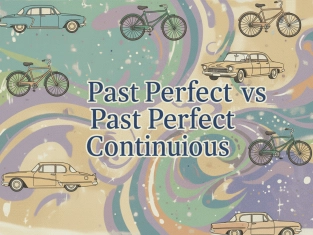Narrative Tenses - All Past Tenses
Table of Contents
Exercises
Explanation
The four narrative tenses are:
-
Past Simple
-
Past Continuous
-
Past Perfect
-
Past Perfect Continuous
1. Past Simple
We use the Past Simple for finished actions in the past or for events that happened in sequence.
Form
-
Affirmative: subject + V2
-
Negative: subject + didn’t + V1
-
Questions: Did + subject + V1?
Examples
-
Liam opened the window and sat down.
-
We didn’t have time to cook dinner.
-
Did you visit the museum last weekend?
Use
-
A completed action
-
A series of events
-
Repeated actions in the past
2. Past Continuous
We use the Past Continuous to talk about an ongoing action at a moment in the past, background descriptions, or two actions happening at the same time.
Form: was / were + verb-ing
Examples
-
She was reading when her phone rang.
-
The children were playing while their parents cooked.
-
It was snowing all evening.
Use
-
An action happening at a specific past moment
-
Two actions happening at the same time
-
A background scene in a story
3. Past Perfect
We use the Past Perfect to show that one action happened before another past action.
Form: had + V3
Examples
-
I had packed my bag before the taxi arrived.
-
He had never tried sushi before that dinner.
-
By the time we got there, the show had started.
Use
-
The earlier of two past actions
-
Explaining a cause or reason in the past
4. Past Perfect Continuous
We use this tense to talk about a long action that continued up to another moment in the past.
Form: had been + verb-ing
Examples
-
They had been studying for hours before the test began.
-
She had been waiting for a long time when I arrived.
-
His hands were dirty because he had been fixing the bike.
Use
-
A long action before another event
-
Explaining a past result (tired, wet, angry, etc.)
How These Tenses Work Together in Stories
When telling a story, we usually mix the tenses:
-
Past Simple → main events
Emma opened the door and walked inside. -
Past Continuous → background
The rain was falling softly outside. -
Past Perfect → earlier events
She realised she had forgotten her keys. -
Past Perfect Continuous → long earlier actions
She had been looking for them all morning.
Quick Summary Table
|
Tense |
Use |
Example |
|
Past Simple |
Finished events |
She arrived late. |
|
Past Continuous |
Background or interrupted actions |
She was driving when it started to rain. |
|
Past Perfect |
Earlier past action |
She had left before we called. |
|
Past Perfect Continuous |
Long earlier action |
She had been working all day. |

